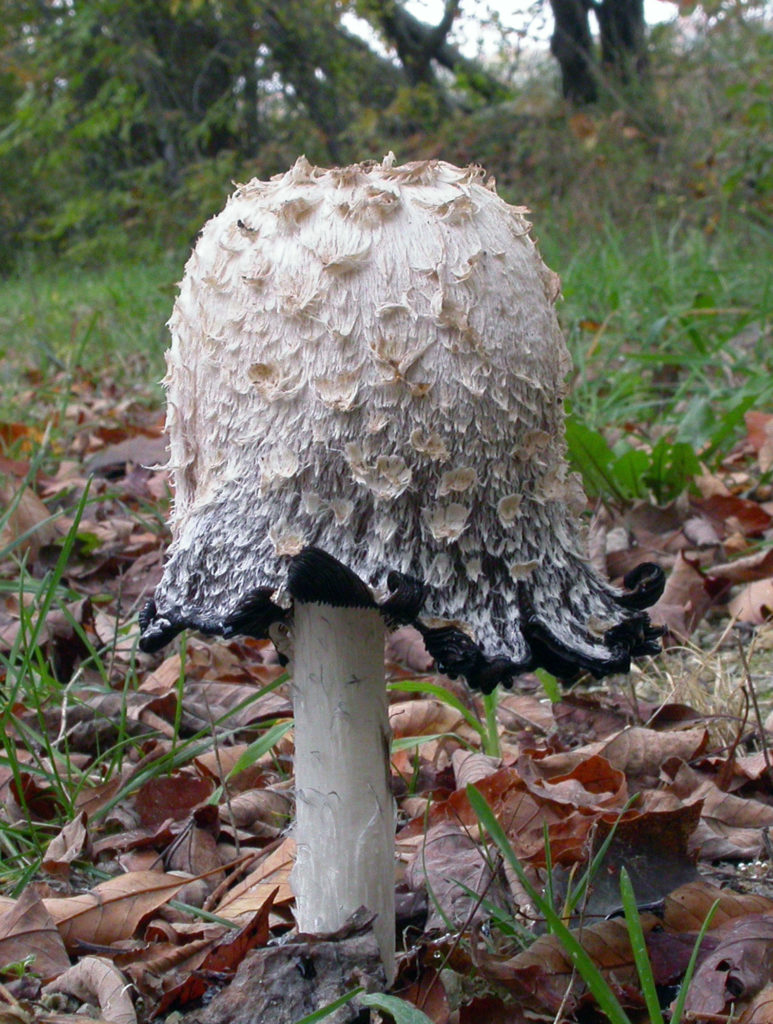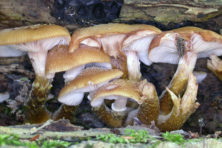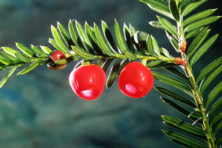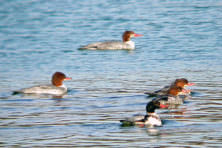Roy & Charlotte Lukes: More Mushrooms!
- Share
- Tweet
- Pin
- Share

So many friends are telling me of all the mushrooms they see on their walks in our county parks and preserves, and even in their own yards. The autumn rains have not been as heavy as I wish but there has been enough to keep the fungi flourishing. Once we received a cold spell, two of my favorites for eating – the honey caps and the shaggy manes – came out.
The shaggy mane is one of the most easily recognized mushrooms as they decorate many roadsides and lawns. A favorite name of this widespread fleshy fungus in England is lawyer’s wig, due to the rough white curled up surface when they are fresh.
Mycologists would call it Coprinus comatus (co-PRY-nus co MAY-tus). Coprinus is from a Greek word meaning dung, called that because many in this group are found growing on manure piles or on richly manured ground. Comatus is from coma, which means hair. Both scientific and common manes refer to its shaggy scales that cover the cap.

Shaggy Mane mushrooms have “unruly hair” and quickly dissolve into an inky mess. Photo by Roy Lukes.
Shaggies are fast growers. They may appear as little light-colored buttons one morning, have perfectly developed into two to seven-inch white “parasols” by the next morning, and will have turned into a black inky mess later that same day. The entire process might be completed within 48 hours.
The term “deliquesce” describes this mushroom’s manner of liquefying into the black fluid thereby spreading its spores; it’s caused by an enzyme in the mushroom. Charlotte’s poem of this sequence is brief and to the point: “Shaggy manes are really strange. They spring up white overnight, then deliquesce into such a mess!”
This fascinating plant could serve as an outstanding example of mushroom power. Stories tell of them pushing small blocks of concrete sidewalks an inch or two upward. We have seen them break up edges of blacktop roads as they force their way through with no apparent damage to the caps. These otherwise delicate fungi have been known to ruin tennis courts!
The outer flesh of the cap is so thin that one can clearly see the vertical lines of the closely packed gills. In fact the cap is mostly gills. They are broad, white at first, pinkish from the bottom up and finally dissolving into a black inky fluid.
Its stem extends up through the encircling gills nearly to the top of the cap. It can reach a length of up to ten inches in wet years and is white, hollow and has a small ring that is rather fragile and movable.
We pick only those that are pure white, clean them and cook them as soon as possible. If you store them in your refrigerator they will turn into a black inky mess. When collecting edible species it is best to cut the stem above the ground so that you can bring home a clean product.
If you are examining mushrooms on a walk and think you have found a good white edible one, be sure to examine all parts. The deadly white Amanita has what’s called a “death cup” often hidden below the ground. If you were to cut the stem at ground level you would miss a vital part of the mushroom for proper identification.

Beware of innocent looking white-gilled mushrooms in the woods. This deadly Amanita reveals its “death cup” at the base of the stalk. Photo by Charlotte Lukes.
The deadly Amanitas are responsible for about 90 percent of fatalities from eating poisonous mushrooms. The toxin in these beautiful mushrooms destroys your liver and kidneys; and it may take six to 10 agonizing days before you succumb.
Late summer into fall the woodlands are decorated with many colorful small mushrooms in the Hygrophorus family. Their common names are waxy caps. Colors range from white to deep yellows, many shades of oranges and reds, and even a green one can be found. The green is caused by a chemical in the fruiting body, not by chlorophyll. This green one is called the parrot waxy cap because it changes to a golden yellow as it ages. I like to call it the Green Bay Packer mushroom – green and gold.
A trip to Rock Island State Park a few weeks ago had us walking ever so slowly down one of the trails. There were so many mushrooms we could not step far without seeing several that required close examination. Photographs were taken and we made notes about the habitat, manner of growth and the host, whether it was growing on wood or on soil, and then the entire fruiting body was picked and cleaned of any dirt.
When doing study of several species in an area it is important to keep good records of each kind and then to store them in separate waxed paper bags so they don’t get mixed up. We do spore prints and do a more detailed examination of each kind when we get home. Never place your mushrooms in plastic bags. The high moisture content of each will cause rapid deterioration and you will have a fluid mess when returning home.
Our Rock Island trip gave us two new species to add to the Door County list. I tell friends that each time I go out looking for mushrooms it is like a treasure hunt. You never know what surprises you may find. Then after all the work of doing further detailed study at home, making spore prints and letting them sit overnight to get good heavy deposits, I awake the next morning and can’t wait to go downstairs to “see what Santa left for me.” I’m like a child at Christmas.
Get out and enjoy these cool autumn days and look around you at all the colorful mushrooms decorating the woodlands. Be extra careful if you intend to eat any wild mushrooms. It may be best to only consume those sold at the grocery stores.




